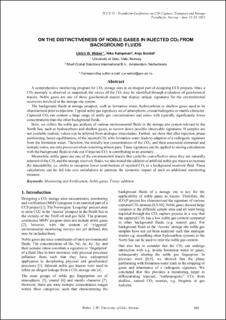| dc.description.abstract | A comprehensive monitoring program for CO2 storage sites is an integral part of designing CCS projects. Once a CO2 anomaly is observed or suspected, the source of the CO2 may be identified through evaluation of geochemical tracers. Noble gases are one of those geochemical tracers that display unique signatures for the environmental reservoirs involved in the storage site system. The background fluids at storage prospect, such as formation water, hydrocarbons or shallow gases need to be characterized prior to injection. Typical noble gas signatures are of atmospheric, crustal/radiogenic or mantle character. Captured CO2 can contain a large range of noble gas concentrations and ratios with typically significantly lower concentrations than the other background fluids. Here, we collect the noble gas analysis of various environmental fluids in the storage site system relevant to the North Sea, such as hydrocarbons and shallow gases, to narrow down possible observable signatures. If samples are not available realistic values can be inferred from analogue sites/studies. Further, we show that after injection, phase partitioning, hence equilibration, of the injected CO2 with formation water leads to adaption of a radiogenic signature from the formation water. Therefore, the initially low concentrations of the CO2, and their associated elemental and isotopic ratios, are only preserved when remaining almost pure. These signatures can be applied to mixing calculations with the background fluids to rule out if injected CO2 is contributing to an anomaly. Meanwhile, noble gases are one of the environmental tracers that could be cost-effective since they are naturally inherent in the CO2 and the storage reservoir fluids, we also model the addition of artificial noble gas tracers to increase the detectability, i.e. ability to recognize lower contributions of injected CO2 in a background reservoir fluid. These calculations can be fed into cost calculations to estimate the economic impact of such an additional monitoring measure. | en_US |

